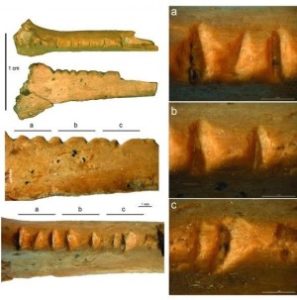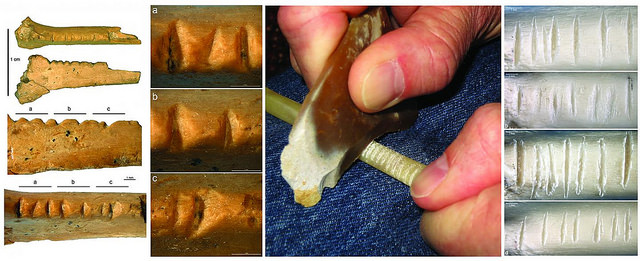
PLOS—The cognitive abilities of Neanderthals are debated, but a raven bone fragment found at the Zaskalnaya VI (ZSK) site in Crimea features two notches that may have been made by Neanderthals intentionally to display a visually consistent pattern, according to a study* by Ana Majkic at the Universite de Bordeaux and colleagues, published in the open access journal, PLOS ONE on March 29, 2017.
Majkic and colleagues conducted a mixed-methods study to assess whether the two extra notches on the ZSK raven bone were made by Neanderthals with the intention of making the final series of notches appear to be evenly spaced. First, researchers conducted a multi-phase experiment where recruited volunteers were asked to create evenly spaced notches in domestic turkey bones, which are similar in size to the ZSK raven bone. Morphometric analyses reveal that the equal spacing of the experimental notches was comparable to the spacing of notches in the ZSK raven bone, even when adjusted for errors in human perception. Archaeological specimens featuring aligned notches from different sites were also analyzed and compared with the ZSK raven bone specimen.
Researchers concluded that the two extra notches on the ZSK raven bone may have been made by Neanderthals intentionally to create a visually consistent, and perhaps symbolic, pattern.
________________________________________
Left: notched raven bone from Zaskalnaya VI Neanderthal site, Crimea. center: experimental notching of a bird bone; right: sequences of experimentally made notches compared to those from Zaskalnaya VI. Credit: Francesco d’Errico
________________________________________________________
A series of recent discoveries of altered bird bones across Neanderthal sites has caused many researchers to argue that the objects were used for personal ornaments, as opposed to butchery tools or activities. But this study is the first that provides direct evidence to support a symbolic argument for intentional modifications on a bird bone.
Article Source: PLOS news release
______________________________________________________
*Majki A, Evans S, Stepanchuk V, Tsvelykh A, d’Errico F (2017) A decorated raven bone from the Zaskalnaya VI (Kolosovskaya) Neanderthal site, Crimea. PLoS ONE 12(3): e0173435. doi:10.1371/journal.pone.0173435
______________________________________________________
Subscribe to Popular Archaeology Premium. Available on all laptops and mobile devices, and still the industry’s best value at only $9.00 annually.
___________________________________________
Travel and learn with Far Horizons.
____________________________________________
This richly illustrated issue includes the following stories: Recent findings shedding new light on the whereabouts of the remains of Philip of Macedon, father of Alexander the Great; how an archaeologist-sculptor is bringing bones of the dead back to life; archaeologists uncovering town life at the dawn of civilization; an exclusive interview with internationally acclaimed archaeologist James M. Adovasio about what makes the Meadowcroft Rockshelter prominent in the ongoing search for the first Americans; what archaeologists are finding at the site of the ancient city of Gath, the home town of the biblical Philistine giant, Goliath; and how scientists are redrawing the picture of human evolution in Europe. Find it on Amazon.com.






